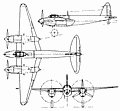 |
De Havilland D.H.98 Mosquito1940 |  |
| FIGHTER, BOMBER | Virtual Aircraft Museum / United Kingdom / De Havilland |
 |
Most aviation enthusiasts will know the usual stories of de Havilland's "wooden wonder", the all-wood bomber which was first planned by the company in 1938. It was to carry no defensive armament, relying upon superior speed to evade enemy aircraft. However realisation of a prototype was delayed for one reason and another until the beginning of 1940. This first prototype, of quite unorthodox construction, flew for the first time on 25 November 1940. When demonstrated to official guests at Hatfield, they were astounded to see its fighter-like manoeuvrability and its amazing performance with one engine feathered. Key to this performance was the lightweight wooden construction: a plywood-balsa-plywood sandwich producing a resilient but light fuselage structure which could accept an enormous amount of punishment, and yet retain its integrity. Power plant comprised two Rolls-Royce Merlin in-line engines, driving constant-speed and fully feathering propellers. The second and third prototypes were fighter and reconnaissance variants respectively. The Mosquito was to prove that it was more than capable of performing any task, and in the process is remembered as a truly outstanding British aircraft of World War II. There had, of course, been some official misgivings that such an unorthodox aircraft could carry out its combat task and survive in the war skies over Europe. In fact later versions capable of higher performance showed that the original de Havilland concept of an aircraft too fast to be intercepted was correct. Towards the end of the war Mosquito units were averaging one aircraft loss per 2,000 sorties - by far the lowest figure recorded by Bomber Command. Many Mosquito variants were built within the three bomber/fighter/reconnaissance categories the first into service being PR aircraft which made their initial daylight sorties over Paris on 20 September 1941. PR Mosquitoes also had the distinction of being the last in RAF front-line service, being withdrawn in December 1955. Mosquito bombers, which had entered service carrying a 907kg bomb load, were later to carry a 1800kg block-buster in a bulged bomb bay. Mosquito fighters were to distinguish themselves in fighter-bomber, anti-shipping and night-fighter roles, and were to destroy some 600 V-1 flying-bombs in the defence of Britain. For reconnaissance duties the Mosquito was the RAF's major long-range aircraft in this category, serving in Europe, Burma and the South Pacific. Including 1,342 Mosquitoes built in Australia and Canada, total construction was 7,781 aircraft when production ended in November 1950

|  COMPANY PROFILE | |||||||||||||||||||||||||||||||||||||||||||||||||||||||||||||||
 |

|

